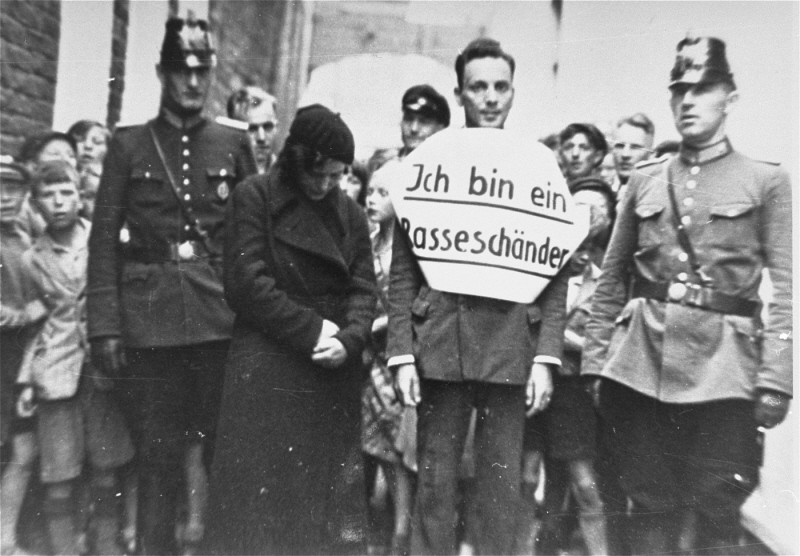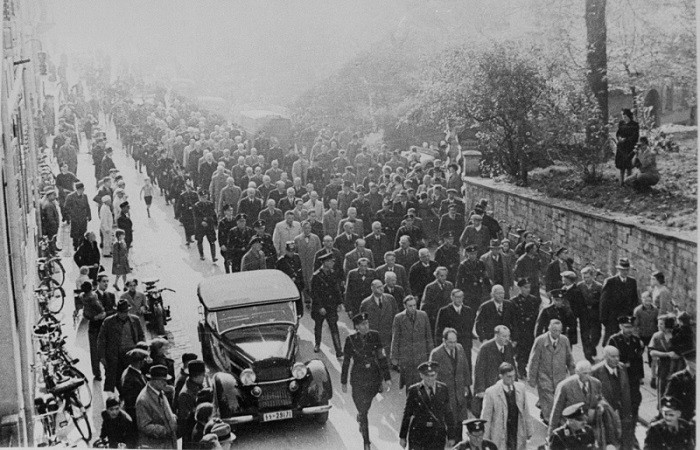
Public Humiliation
During the twelve years of the Third Reich (1933-1945), Nazi officials and organizations perpetrated public humiliations of individuals in Germany and Nazi-occupied countries. The Nazis singled out Jews and other victims who violated racial laws as targets for humiliation. For example, Jewish men often had their beards forcibly shaved and endured physical punishment.
Key Facts
-
1
Degrading episodes were carried out by ordinary citizens, the police, the military, and SS officers or soldiers. Men, women, and children were all targets for humiliation.
-
2
Humiliating incidents were intended to embarrass individuals as well as to deliver or reinforce lessons about Nazi racial ideology and power.
-
3
Humiliation was incorporated into day-to-day life under the Nazis, and it was also a significant component of major events, such as the Anschluss and Kristallnacht.
Background and Context
Humiliation is one of the most powerful human emotions, causing feelings of shame and degradation. To humiliate someone means to violate the dignity of a person by disregarding their basic human rights. The humiliations the Nazis inflicted on Jews and other victims were not accidental, but rather intrinsic to the Nazi program of racist oppression. The Nazis used humiliation tactics not only to debase their victims, but also to reinforce lessons about racial hierarchy for German citizens and populations under Nazi occupation. Since the humiliation was public, it functioned further as a warning to anyone who transgressed Nazi racial law. Moreover, Nazis knew well how potent humiliation could be, as many German politicians considered the Treaty of Versailles, which concluded World War I in 1919, to be a national humiliation of Germany.

Public humiliation under the Nazis had three primary functions.
- The first function was to exacerbate the suffering of Nazi victims.
- Second, public humiliation served to remind the German public about the risks of opposing the Nazi Party.
- Lastly, it functioned as a way to visibly degrade victims in order to create critical distance between the Nazis and their victims. Differentiating themselves from their victims in this way made it easier for Nazis to perpetrate horrific acts of violence against people who otherwise were just like them.
In 1971, the British journalist Gitta Sereny asked Franz Stangl, the commandant of Treblinka, about the purpose of humiliating victims: “Why, if they [the Nazis] were going to kill them [the victims] anyway, what was the point of all the humiliation, why the cruelty?” Stangl replied: “To condition those who actually had to carry out the policies. To make it possible for them to do what they did.”
Individual Humiliations
Many humiliations took place on the individual level, singling out one or two people for humiliation as a form of punishment, often for supposed “racial defilement.” These cases usually involved people in “mixed-race” romantic relationships, such as “Aryans” who dated or married “racially inferior” Jews or Slavs.
In 1941, officials in present-day Ścinawa Nyska, then Steindorf in German-occupied Silesia, Poland, discovered a romance between Polish and German teenagers. Bronia (last name unknown) was a sixteen-year-old Polish forced laborer working on a farm in Nazi-occupied Poland. Gerhard Greschok was a nineteen-year-old German working on the same farm. As sexual relationships between Germans and Poles were forbidden under Nazi racial policy, local officials organized a very public ritual humiliation of Bronia and Gerhard. The two were paraded barefoot through the town, forced to wear signs reading “I am a Polish pig” (Bronia) and “I am a traitor to the national community” (Gerhard). Their heads were shaved, and then, as punishment, Bronia was sent to a concentration camp and Gerhard to the eastern front of the war.
Jews were also frequent targets for this type of individual humiliation. In 1933, a Jewish lawyer named Michael Siegel went to the Munich police to file a report on behalf of his Jewish client, Max Uhlfelder. At the police station, Siegel was physically beaten by members of the SS. The SA then marched Siegel, barefoot and with his pants cut off, through the streets of Munich. Siegel was also forced to wear a sign around his neck stating he would never again complain to the police. Photographs of Siegel as he was hounded through the streets by the SA then appeared in American newspapers.
Other forms of humiliation specifically targeted symbols of Jewish identity. Many religious Jewish men wore beards and sidelocks, which were forcibly cut off during humiliations. In addition, their heads were shaved. Other Jews were forced to pose with Jewish ritual objects including tallitim and tefillin, or to remove traditional skull caps. Sometimes the humiliation was compounded by forcing Jews to debase each other, such as having one Jew shave the beard of another.
The Anschluss and Kristallnacht
Humiliation was also a key component of organized public events such as the Anschluss and Kristallnacht. Germany annexed Austria in a carefully choreographed event known as the Anschluss in March 1938. Public humiliations of Austria’s Jewish communities were an essential component of the Anschluss, used to demonstrate the power and priorities of the new regime. In Vienna, Jews were forced to scrub the streets on their hands and knees, while Nazi officials and neighbors watched. This was repeated in other cities and villages throughout the war, along with other group humiliations such as forced exercise. In another example, Austrian Nazis compelled two Jewish men to paint “Jude” on the fronts of Jewish-owned businesses in Vienna.
Jewish humiliation was also central to Kristallnacht, the state-organized pogrom in November 1938. As a demonstration of Jewish ostracism and vulnerability, the pogrom was itself humiliating. Synagogues, Jewish businesses, and other Jewish properties were utterly destroyed. Nazis entered Jewish residences, stealing whatever they liked and ruining possessions. During Kristallnacht, men were arrested to be deported, but were first forced to march through the streets under armed guard for their families and neighbors to see.

Institutional and Systemic Humiliation
Humiliation pervaded the Nazi state and its institutions. Under the Nuremberg Laws (1935) and similar antisemitic legislation, Jews were systematically excluded from daily life in Germany in ways that were meant to be humiliating as well as punitive. Jews were required to wear the Star of David on their clothes as a visual marker of difference. New rules imposed curfews on Jews and restricted when and where they were able to shop and use public transit. Benches and other public amenities were divided, with some labeled “Only for Aryans” or “Forbidden to Jews,” while others were designated with a “J” for Jews.
Ghettos and camps were also inherently humiliating. Conditions in the ghettos, due to overcrowding, lack of food, and poor sanitation, were deeply degrading. Ghetto life interfered with normal family structures and disrupted traditional gender roles, often generating shame when people were no longer able to provide for and protect their families as they were accustomed to doing.
The concentration camps amplified the degradation of the ghettos, introducing new forms of humiliation that underscored the powerlessness of the individual. Concentration camps were designed to strip individuals of their humanity and debase inmates, which the camps did effectively. Heads were shaved, regular clothes replaced with ill-fitting prison uniforms, and in some cases, identification numbers were tattooed onto bodies. Personal privacy was eliminated, food was sharply restricted, and opportunities for hygiene were limited. Every aspect of prisoners’ lives was controlled by someone else, and camp officials took every opportunity to remind inmates of this control. Such practices were not only intended to humiliate and shame inmates, but they were also designed to create the degraded beings depicted in German propaganda, therefore producing the very threat Nazism promised to eradicate.
Footnotes
-
Footnote reference1.
Evelin Lindner. Making Enemies: Humiliation and International Conflict (Westport, CT: Praeger Security International, 2006), xiv-xv.
-
Footnote reference2.
Gitta Sereny. Into That Darkness: An Examination of Conscience (New York: Random House, 1974), 101. Original text in italics.
Critical Thinking Questions
What pressures and motivations might have affected the choices of people who perpetrated these events?
Who may have witnessed these events of public humiliation?
What pressures and motivations might have affected an observer’s choices as they witnessed a public humiliation of Jews? Are these factors specific to the time period, or are they universal?

